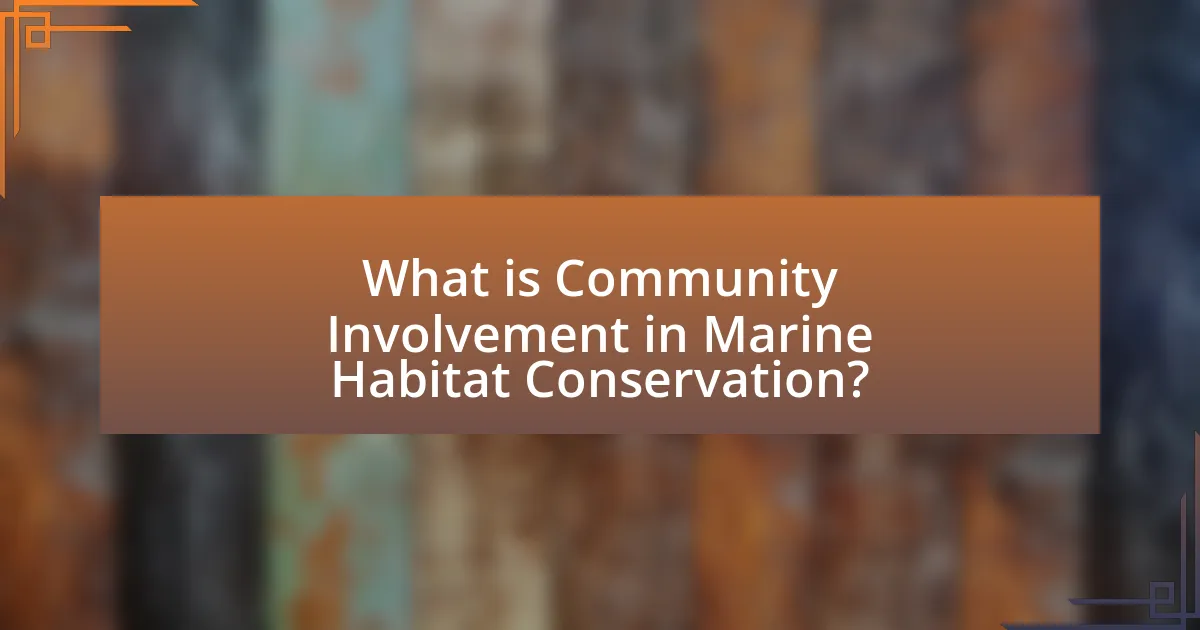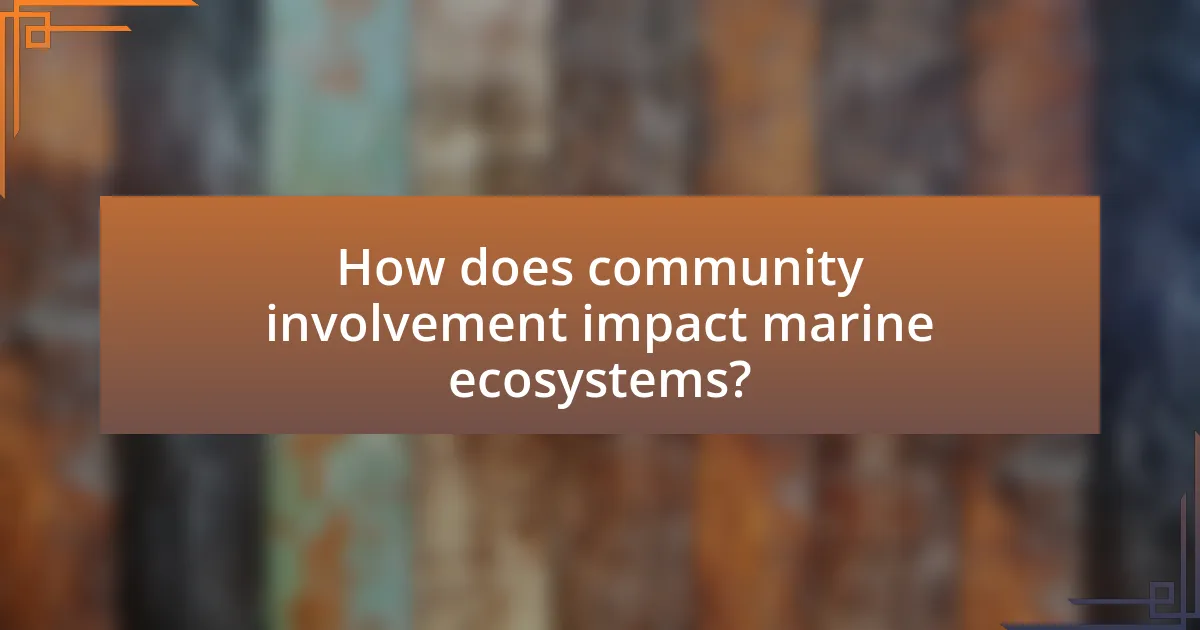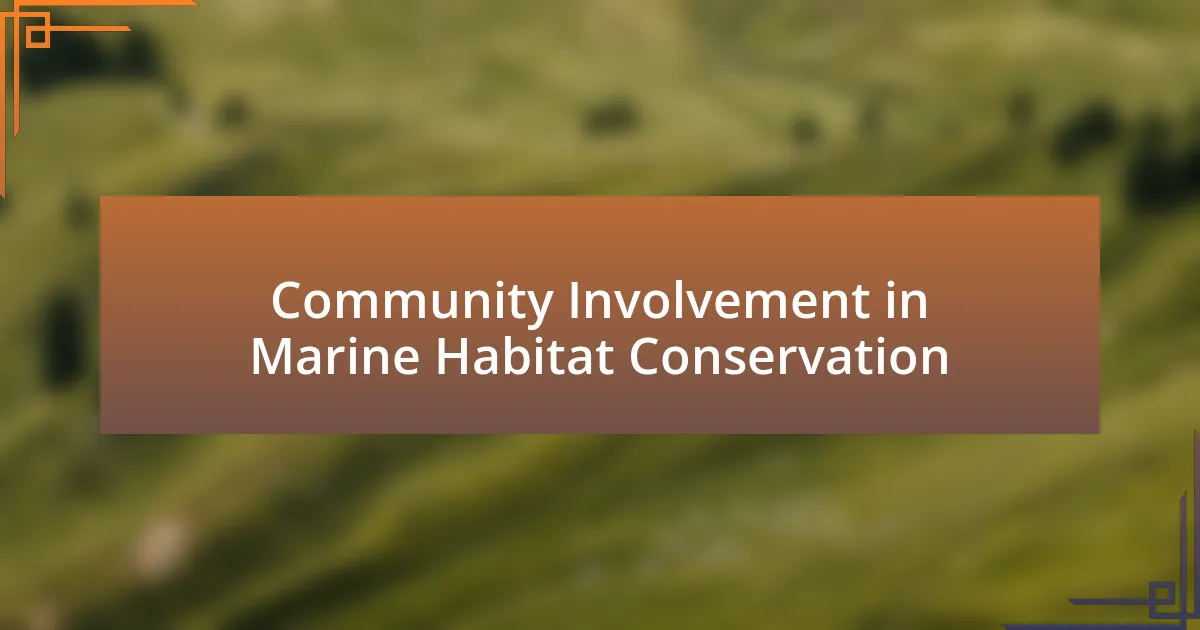Community involvement in marine habitat conservation encompasses the active participation of local communities in protecting and managing marine ecosystems. This article outlines the significance of community engagement, highlighting its role in enhancing biodiversity, fostering local stewardship, and improving conservation outcomes. Key principles such as active participation, integration of local knowledge, and equitable benefit-sharing are discussed, along with the challenges communities face, including economic pressures and regulatory hurdles. The article also emphasizes successful strategies and collaborative projects that communities can implement to promote sustainable practices and effectively contribute to marine habitat conservation.

What is Community Involvement in Marine Habitat Conservation?
Community involvement in marine habitat conservation refers to the active participation of local communities in the protection and management of marine ecosystems. This involvement can include activities such as volunteering for clean-up efforts, participating in educational programs, and contributing to policy-making processes that affect marine environments. Research indicates that when communities are engaged in conservation efforts, there is often a higher success rate in preserving biodiversity and enhancing ecosystem resilience, as seen in various case studies where local stewardship has led to improved marine health and sustainability.
Why is community involvement crucial for marine habitat conservation?
Community involvement is crucial for marine habitat conservation because it fosters local stewardship and enhances the effectiveness of conservation efforts. Engaging communities in conservation initiatives leads to increased awareness and understanding of marine ecosystems, which can result in more sustainable practices. For instance, studies have shown that when local communities participate in conservation planning and decision-making, the success rates of marine protected areas increase significantly, with some reports indicating up to a 50% improvement in biodiversity outcomes. This is largely due to the local knowledge and commitment that community members bring, which can lead to more tailored and effective conservation strategies.
What roles do local communities play in protecting marine habitats?
Local communities play a crucial role in protecting marine habitats through stewardship, sustainable practices, and advocacy. These communities often possess traditional ecological knowledge that informs conservation efforts, enabling them to manage local resources effectively. For instance, community-led initiatives such as marine protected areas (MPAs) have been shown to enhance biodiversity and fish stocks, as evidenced by studies indicating that MPAs can lead to a 20-50% increase in fish populations within their boundaries. Additionally, local communities engage in monitoring and enforcement activities, ensuring compliance with regulations that protect marine ecosystems. Their involvement fosters a sense of ownership and responsibility, which is essential for the long-term sustainability of marine habitats.
How does community engagement enhance conservation efforts?
Community engagement enhances conservation efforts by fostering local stewardship and increasing awareness of environmental issues. When communities actively participate in conservation initiatives, they develop a sense of ownership and responsibility towards their natural resources, leading to more sustainable practices. Research indicates that community-led conservation projects, such as those in marine habitats, often result in improved biodiversity outcomes and more effective resource management. For instance, a study published in the journal “Conservation Biology” found that areas with strong community involvement in marine conservation saw a 30% increase in fish populations compared to those without such engagement. This demonstrates that when local communities are empowered and educated about conservation, they can significantly contribute to the success of these efforts.
What are the key principles of community involvement in conservation?
The key principles of community involvement in conservation include active participation, local knowledge integration, equitable benefit-sharing, and fostering stewardship. Active participation ensures that community members are engaged in decision-making processes, which enhances ownership and commitment to conservation efforts. Integrating local knowledge allows for culturally relevant and effective conservation strategies, as communities often possess valuable insights about their environment. Equitable benefit-sharing ensures that the advantages of conservation initiatives are distributed fairly among community members, promoting social equity and support for conservation goals. Finally, fostering stewardship encourages a sense of responsibility and care for the environment, leading to sustainable practices that benefit both the community and the ecosystem. These principles are supported by various case studies demonstrating successful community-led conservation projects, such as the involvement of local fishers in managing marine protected areas, which have shown improved biodiversity and fish stocks.
How do collaboration and partnership influence conservation outcomes?
Collaboration and partnership significantly enhance conservation outcomes by pooling resources, expertise, and stakeholder engagement. When diverse groups, including local communities, governments, and NGOs, work together, they create more comprehensive strategies that address ecological challenges effectively. For instance, a study by the World Resources Institute found that collaborative marine management initiatives led to a 30% increase in fish populations in areas where local fishers were actively involved in decision-making processes. This demonstrates that partnerships not only improve ecological health but also foster community stewardship, leading to sustainable conservation practices.
What strategies can communities employ to promote marine habitat conservation?
Communities can employ strategies such as establishing marine protected areas (MPAs), promoting sustainable fishing practices, and engaging in habitat restoration projects to promote marine habitat conservation. MPAs help safeguard critical ecosystems by restricting harmful activities, which has been shown to enhance biodiversity and fish populations, as evidenced by a study published in “Nature” that found MPAs can lead to a 20-50% increase in fish biomass. Sustainable fishing practices, including catch limits and gear restrictions, reduce overfishing and protect juvenile fish, contributing to healthier marine environments. Additionally, community-led habitat restoration initiatives, such as mangrove replanting and coral reef rehabilitation, have demonstrated success in restoring ecosystem functions and improving resilience against climate change impacts, as reported by the “Global Environment Facility.” These strategies collectively empower communities to take active roles in conserving marine habitats.

How does community involvement impact marine ecosystems?
Community involvement positively impacts marine ecosystems by fostering conservation efforts and enhancing biodiversity. Engaged communities often participate in activities such as beach clean-ups, habitat restoration, and sustainable fishing practices, which directly contribute to the health of marine environments. For instance, a study published in the journal “Marine Policy” found that local community-led initiatives in coastal areas led to a 30% increase in fish populations over five years, demonstrating the effectiveness of grassroots involvement in marine conservation. Additionally, when communities are educated about the importance of marine ecosystems, they are more likely to advocate for policies that protect these environments, further amplifying their positive impact.
What are the ecological benefits of community-led conservation initiatives?
Community-led conservation initiatives provide significant ecological benefits, including enhanced biodiversity, improved habitat restoration, and increased resilience to environmental changes. These initiatives often involve local knowledge and practices that are tailored to specific ecosystems, leading to more effective management of natural resources. For instance, studies have shown that areas managed by local communities can experience up to 50% higher biodiversity compared to those under government management alone. Additionally, community involvement fosters stewardship, resulting in better protection of marine habitats, such as coral reefs and mangroves, which are crucial for carbon sequestration and coastal protection. This collaborative approach not only conserves ecosystems but also empowers communities, creating a sustainable model for conservation that can adapt to changing environmental conditions.
How do local practices contribute to biodiversity preservation?
Local practices contribute to biodiversity preservation by promoting sustainable resource management and fostering community stewardship of natural habitats. For instance, traditional fishing practices often involve seasonal closures and selective harvesting, which help maintain fish populations and ecosystem balance. Research conducted by the World Wildlife Fund indicates that communities engaged in local conservation efforts, such as establishing marine protected areas, can lead to a 30% increase in biodiversity within those regions. Additionally, local knowledge and cultural practices often prioritize the protection of native species and habitats, further enhancing biodiversity.
What evidence supports the effectiveness of community involvement in conservation?
Community involvement in conservation is supported by evidence showing improved biodiversity outcomes and enhanced resource management. For instance, a study published in “Conservation Biology” by Berkes (2009) demonstrated that local communities engaged in co-management of marine resources led to a 30% increase in fish populations compared to areas without community involvement. Additionally, the “Marine Policy” journal reported that community-led initiatives in the Caribbean resulted in a 50% reduction in illegal fishing activities, highlighting the effectiveness of local stewardship in protecting marine habitats. These examples illustrate that active participation of communities not only fosters sustainable practices but also leads to measurable ecological benefits.
How can communities effectively mobilize for marine habitat conservation?
Communities can effectively mobilize for marine habitat conservation by organizing local initiatives that promote awareness, education, and active participation in conservation efforts. For instance, community-led beach clean-ups and habitat restoration projects engage residents and foster a sense of ownership over local marine environments. Research indicates that community involvement significantly enhances conservation outcomes; a study published in the journal “Conservation Biology” found that local stewardship initiatives led to a 30% increase in biodiversity in targeted areas. By leveraging local knowledge and resources, communities can create sustainable practices that protect marine habitats while also building resilience against environmental changes.
What tools and resources are available for community engagement?
Tools and resources available for community engagement in marine habitat conservation include online platforms, educational programs, and collaborative initiatives. Online platforms such as social media and community forums facilitate communication and information sharing among stakeholders. Educational programs, like workshops and seminars, provide knowledge about marine ecosystems and conservation practices. Collaborative initiatives, such as citizen science projects, enable community members to participate actively in data collection and monitoring efforts. These resources enhance community involvement, fostering a collective approach to marine habitat conservation.
How can education and awareness campaigns foster community participation?
Education and awareness campaigns can foster community participation by providing essential knowledge and understanding of marine habitat conservation issues. These campaigns engage community members through workshops, informational sessions, and outreach programs that highlight the importance of local ecosystems and the impact of human activities on marine life. For instance, studies have shown that communities involved in educational initiatives are more likely to participate in conservation efforts, as evidenced by a 2018 report from the National Oceanic and Atmospheric Administration, which found that areas with active educational programs saw a 30% increase in volunteer participation for marine conservation activities. By equipping individuals with the necessary information and skills, education and awareness campaigns empower communities to take action, thereby enhancing their involvement in protecting marine habitats.

What challenges do communities face in marine habitat conservation?
Communities face significant challenges in marine habitat conservation, primarily due to economic pressures, lack of awareness, and regulatory hurdles. Economic pressures arise from reliance on marine resources for livelihoods, leading to overfishing and habitat degradation. For instance, coastal communities often prioritize short-term economic gains over long-term sustainability, resulting in detrimental practices like destructive fishing methods.
Lack of awareness about the importance of marine ecosystems further complicates conservation efforts, as community members may not fully understand the ecological impacts of their actions. Educational initiatives are often insufficient, leaving gaps in knowledge that hinder effective participation in conservation efforts.
Regulatory hurdles also pose challenges, as existing laws may be inadequate or poorly enforced, allowing harmful activities to continue unchecked. For example, inconsistent policies across different jurisdictions can create confusion and limit community engagement in conservation initiatives. These factors collectively undermine the effectiveness of marine habitat conservation efforts at the community level.
What are the common obstacles to effective community involvement?
Common obstacles to effective community involvement in marine habitat conservation include lack of awareness, insufficient resources, and limited access to decision-making processes. Lack of awareness often stems from inadequate education and outreach efforts, which can prevent community members from understanding the importance of marine conservation. Insufficient resources, such as funding and manpower, hinder the ability of communities to engage in conservation activities effectively. Limited access to decision-making processes can result in community voices being overlooked, leading to a disconnect between conservation initiatives and local needs. These factors collectively impede the potential for meaningful community participation in marine habitat conservation efforts.
How do socio-economic factors influence community participation?
Socio-economic factors significantly influence community participation by determining individuals’ access to resources, education, and social networks. Communities with higher income levels often have better access to information and opportunities for involvement, leading to increased participation in initiatives like marine habitat conservation. For instance, a study by the World Bank found that communities with higher educational attainment are more likely to engage in environmental conservation efforts, as education fosters awareness and understanding of ecological issues. Additionally, socio-economic status can affect the availability of time and financial resources, which are critical for active participation in community projects.
What role does policy play in supporting or hindering community efforts?
Policy plays a crucial role in either supporting or hindering community efforts in marine habitat conservation. Supportive policies can provide funding, resources, and legal frameworks that empower communities to engage in conservation activities, as seen in the implementation of the Coastal Zone Management Act, which encourages local participation in coastal resource management. Conversely, restrictive policies can limit community access to marine resources or impose regulations that are difficult for local stakeholders to comply with, thereby undermining their conservation initiatives. For instance, the establishment of marine protected areas without community input can lead to resistance and reduced effectiveness of conservation efforts.
How can communities overcome barriers to participation?
Communities can overcome barriers to participation by fostering inclusive environments that prioritize accessibility and engagement. This can be achieved through targeted outreach efforts, such as workshops and informational sessions, that educate community members about marine habitat conservation and its importance. Research indicates that when communities actively involve diverse stakeholders, including marginalized groups, participation rates increase significantly. For instance, a study published in the journal “Environmental Management” found that inclusive decision-making processes led to a 40% increase in community engagement in conservation initiatives. By addressing language barriers, providing transportation options, and ensuring that meetings are held at convenient times, communities can further enhance participation and ensure that all voices are heard in marine habitat conservation efforts.
What best practices can enhance community resilience in conservation efforts?
Best practices that can enhance community resilience in conservation efforts include fostering local participation, integrating traditional ecological knowledge, and promoting education and awareness. Local participation ensures that community members are actively involved in decision-making processes, which increases their investment in conservation outcomes. Integrating traditional ecological knowledge respects and utilizes the insights of indigenous and local communities, leading to more effective and culturally relevant conservation strategies. Promoting education and awareness equips community members with the knowledge necessary to understand the importance of conservation, thereby encouraging sustainable practices. Research indicates that communities engaged in conservation efforts are more likely to adapt to environmental changes, as seen in the case of coastal communities in the Philippines, where local involvement in marine protected areas led to improved fish stocks and biodiversity.
How can successful case studies inform future community initiatives?
Successful case studies can inform future community initiatives by providing evidence-based strategies that demonstrate effective engagement and outcomes. For instance, a case study on the successful restoration of a coastal ecosystem in California highlighted the importance of local stakeholder involvement, which led to a 30% increase in biodiversity over five years. This specific example illustrates how community participation can enhance conservation efforts, guiding future initiatives to adopt similar collaborative approaches. Additionally, analyzing the challenges faced in these case studies allows communities to anticipate potential obstacles and develop proactive solutions, thereby increasing the likelihood of success in future projects.
What practical steps can communities take to engage in marine habitat conservation?
Communities can engage in marine habitat conservation by implementing local initiatives such as organizing beach clean-ups, establishing marine protected areas, and promoting sustainable fishing practices. Beach clean-ups directly reduce pollution and debris that harm marine life, while marine protected areas help preserve critical habitats and biodiversity. Additionally, promoting sustainable fishing practices ensures that fish populations remain healthy and ecosystems are not overexploited. According to the National Oceanic and Atmospheric Administration, marine protected areas can lead to increased fish populations and improved ecosystem health, demonstrating the effectiveness of these community actions.
How can individuals contribute to local conservation efforts?
Individuals can contribute to local conservation efforts by participating in community clean-up events, volunteering for local conservation organizations, and advocating for sustainable practices. Engaging in clean-up activities helps remove debris and pollutants from natural habitats, directly benefiting local ecosystems. Volunteering with organizations focused on conservation provides essential manpower for projects aimed at habitat restoration and species protection. Advocacy for sustainable practices, such as reducing plastic use and supporting local conservation policies, raises awareness and encourages community-wide participation in protecting marine habitats. According to the National Oceanic and Atmospheric Administration, community involvement is crucial for the success of conservation initiatives, as it fosters a sense of stewardship and responsibility towards local environments.
What collaborative projects can communities initiate for effective conservation?
Communities can initiate collaborative projects such as community-led marine protected areas (MPAs) to enhance effective conservation. These MPAs involve local stakeholders in the management and protection of marine ecosystems, ensuring sustainable practices that benefit both the environment and local economies. Research indicates that community-managed MPAs can lead to increased biodiversity and improved fish stocks, as seen in the case of the Apo Island Marine Reserve in the Philippines, where local governance resulted in a 200% increase in fish biomass over a decade. Additionally, communities can engage in habitat restoration projects, such as coral reef rehabilitation, which have been shown to improve ecosystem resilience and support marine life.
